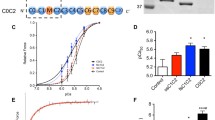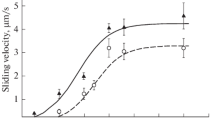Abstract
Smooth muscle myosin isoforms of the heavy chain and the essential light chain have been hypothesized to contribute to the different shortening velocities of phasic and tonic smooth muscles, and to their different affinities for MgADP. We used the baculovirus/insect cell system to express homogeneous heavy meromyosin molecules differing onlyin a seven amino acid insert (QGPSFSY) in the motor domain near the active site, or in the type of essential light chain isoform. Myosin from tonic rabbit uterine smooth muscle lacks the heavy chain insert, while myosin from phasic chicken gizzard contains it. The properties of a mutant uterine heavy meromyosin with added insert, and a mutant gizzard heavy meromyosin with the insert deleted, were compared with their wild type progenitors. Phosphorylated heavy meromyosins with the insert have a twofold higher enzymatic activity and in vitro motility than heavy meromyosins without the insert. These functional properties were not altered by the essential light chain isoforms. The altered motility caused by the insert implies that it modulates the rate of ADP release, the molecular step believed to limit shortening velocity. The insert may thus account in part for both the lower sensitivity to MgADP and the higher shortening velocity of phasic compared to tonic smooth muscles
Similar content being viewed by others
References
BABIJ, P., KELLY, C. & PERIASAMY, M. (1991) Characterization of a mammalian smooth muscle myosin heavy-chain gene: complete nucleotide and protein coding sequence and analysis of the 5′ end of the gene. Proc. Natl. Acad. Sci. USA 88, 10676–80.
BARANY, M. (1967) ATPase activity of myosin correlated with speed of muscle shortening. J. Gen. Physiol. 50, 197–216.
CUDA, G., FANANAPAZIR, L., ZHU, W. Z., SELLERS, J. & EPSTEIN, N. D. (1993) Skeletal muscle expression and abnormal function of β-myosin in hypertrophic cardiomyopathy. J. Clin. Invest. 91, 2861–5.
EDDINGER, T. J. & MURPHY, R. A. (1988) Two smooth muscle myosin heavy chains differ in their light meromyosin fragment. Biochemistry 27, 3807–11.
FUGLSANG, A., KHROMOV, A., TÖRÖK, K., SOMLYO, A. V. & SOMLYO, A.P. (1993) Flash photolysis studies of relaxation and cross-bridge detachment: Higher sensitivity of tonic than phasic smooth muscle to MgADP. J. Muscle Res. Cell Motil. 14, 666–77.
GONG, M. C., COHEN, P., KITAZAWA, T., IKEBE, M., MASUO, M., SOMLYO, A. P. & SOMLYO, A. V. (1992) Myosin light chain phosphatase activities and the effects of phosphatase inhibitors in tonic and phasic smooth muscle. J. Biol. Chem. 267, 14662–8.
GREASER, M. L., MOSS, R. L. & REISER, P. J. (1988) Variations in contractile properties of rabbit single muscle fibres in relation to troponin T isoforms and myosin light chains. J. Physiol. 406, 85–98.
HASEGAWA, Y. & MORITA, F. (1992) Role of 17-kDa essential light chain isoforms of aorta smooth muscle myosin. J. Biochem. 111, 804–9.
HELPER, D. J., LASH, J. A. & HATHAWAY, D. R. (1988) Distribution of isoelectric variants of the 17,000-dalton myosin light chain in mammalian smooth muscle. J. Biol. Chem. 263(30), 15748–53.
HORIUTI, K., SOMLYO, A. V., GOLDMAN, Y. E. & SOMLYO, A. P. (1989) Kinetics of contraction initiated by flash photolysis of caged adenosine triphosphate in tonic and phasic smooth muscles. J. Gen. Physiol. 94, 769–81.
KELLEY, C. A., SELLERS, J. R., GOLDSMITH, P. K. & ADELSTEIN, R. S. (1992) Smooth muscle myosin is composed of homodimeric heavy chains. J. Biol. Chem. 267(4), 2127–30.
KELLEY, C. A., TAKAHASHI, M., YU, J. H. & ADELSTEIN, R. S. (1993) An insert of seven amino acids confers functional differences between smooth muscle myosins from the intestines and vasculature. J. Biol. Chem. 268, 12848–54.
KHROMOV, A., SOMLYO, A. V., TRENTHAM, D. R., ZIMMERMANN, B. & SOMLYO, A. P. (1995) The role of MgADP in force maintenance by dephosphorylated cross-bridges in smooth muscle: a flash photolysis study. Biophys. J. 69, 2611–22.
LITTEN, R. Z., MARTIN, B. J., LOW, R. B. & ALPERT, N. R. (1982) Altered myosin isozyme patterns from pressure overloaded and thyrotoxic hypertrophied rabbit hearts. Circ. Research 50, 856–64.
LOWEY, S., WALLER, G. S. & TRYBUS, K. M. (1993) Skeletal muscle myosin light chains are essential for physiological speeds of shortening. Nature 365, 454–6.
MALMQVIST, U. & ARNER, A. (1991) Correlation between isoform composition of the 17 kDa myosin light chain and maximal shortening velocity in smooth muscle. Pflügers Arch. 418(6), 523–30.
NABESHIMA, Y., NABESHIMA, Y.-I., NONOMURA, Y. & FUJ II-KURIYAMA, Y. (1987) Nonmuscle and smooth muscle myosin light chain mRNAs are generated from a single gene by the tissue-specific alternative RNA splicing. J. Biol. Chem. 262(22), 10608–12.
NAGAI, R., KURO-O, M., BABIJ, P. & PERIASAMY, M. (1989) Identification of two types of smooth muscle myosin heavy chain isoforms by cDNA cloning and immunoblot analysis. J. Biol. Chem. 264(17), 9734–7.
O’REILLY, D. R., MILLER, L. K. & LUCKOW, V. A. (1992) Baculovirus Expression Vectors. A Laboratory Manual. New York: W. H. Freeman and Co.
PERRIE, W. T. & PERRY, S. V. (1970) An electrophoretic study of the low-molecular-weight components of myosin. Biochem. J. 119, 31–8.
RAYMENT, I., RYPNIEWSKI, W. R., SCHMIDT-BÄSE, K., SMITH, R., TOMCHICK, D. R., BENNING, M. M., WINKELMANN, D. A., WESENBERG, G. & HOLDEN, H. M. (1993) Three-dimensional structure of myosin sub-fragment-1: a molecular motor. Science 261, 50–8.
ROVNER, A. S., FREYZON, Y. & TRYBUS, K. M. (1995) Chimeric substitutions of the actin-binding loop activate dephosphorylated but not phosphorylated smooth muscle heavy meromyosin. J. Biol. Chem. 270, 30260–3.
SIEMANKOWSKI, R. F., WISEMAN, M. O. & WHITE, H. D. (1985) ADP dissociation from actomyosin subfragment 1 is sufficiently slow to limit the unloaded shortening velocity in vertebrate muscle. Proc. Natl Acad. Sci. USA 82, 658–62.
SOMLYO, A. P. (1993) Myosin isoforms in smooth muscle: how may they affect function and structure? J. Muscle Res. Cell Motil. 14, 557–63.
SPUDICH, J. A. (1994) How molecular motors work. Nature 372, 515–18.
SWEENEY, H. L., KUSHMERICK, M. J., MABUCHI, K., SRETER, F. A. & GERGELY, J. (1988) Myosin alkali light chain and heavy chain variations correlate with altered shortening velocity of isolated muscle fibers. J. Biol. Chem. 263(18), 9034–9.
SWEENEY, H. L., FAUST, L., SMITH, J. E., BROWN, F., MILLIGAN, R. A., SELLERS, J. R. & STEIN, L. A. (1996) Function of the 25/50 KDA loop of the myosin II motor. Biophys. J. 70(2) (Part 2), A149(Abstract).
TRYBUS, K. M. (1994) Regulation of expressed truncated smooth muscle myosins. Role of the essential light chain and tail length. J. Biol. Chem. 269(33), 20819–22.
TRYBUS, K. M., & HENRY, L. (1989) Monoclonal antibodies detect and stabilize conformational states of smooth muscle myosin. J. Cell Biol. 109(6 Pt 1), 2879–86.
WARSHAW, D. M., DESROSIERS, J. M., WORK, S. S. & TRYBUS, K. M. (1990) Smooth muscle myosin cross-bridge interactions modulate actin filament sliding velocity in vitro. J. Cell Biol. 111(2), 453–63.
WARSHAW, D. M., DESROSIERS, J. M., WORK, S. S. & TRYBUS, K. M. (1991) Effects of MgATP, MgADP and Pi on actin movement by smooth muscle myosin. J. Biol. Chem. 266(36), 24339–43.
WHITE, S., MARTIN, A. F. & PERIASAMY, M. (1993) Identification of a novel smooth muscle myosin heavy chain cDNA: Isoform diversity in the S1 head region. Am. J. Physiol. 264, C1252–8.
YANAGISAWA, M., HAMADA, Y., KATSURAGAWA, Y., IMAMURA, M., MIKAWA, T. & MASAKI, T. (1987) Complete primary structure of vertebrate smooth muscle myosin heavy chain deduced from its complementary DNA Sequence. Implications on topography and function of myosin. J. Mol. Biol. 198, 143–57.
Author information
Authors and Affiliations
Rights and permissions
About this article
Cite this article
ROVNER, A.S., FREYZON, Y. & TRYBUS, K.M. An insert in the motor domain determines the functional properties of expressed smooth muscle myosin isoforms. J Muscle Res Cell Motil 18, 103–110 (1997). https://doi.org/10.1023/A:1018689102122
Issue Date:
DOI: https://doi.org/10.1023/A:1018689102122




